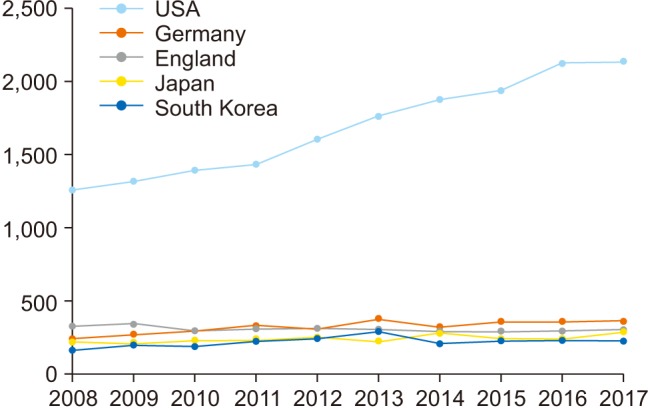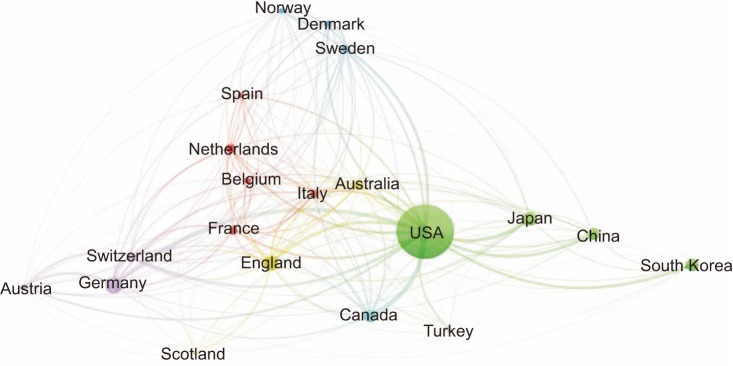Clin Orthop Surg.
2019 Jun;11(2):237-243. 10.4055/cios.2019.11.2.237.
Assessment of Korea's Orthopedic Research Activities in the Top 15 Orthopedic Journals, 2008–2017
- Affiliations
-
- 1Department of Orthopedic Surgery, Bumin Hospital, Busan, Korea.
- 2Department of Orthopaedic Surgery, Seoul Paik Hospital, Inje University College of Medicine, Seoul, Korea. cragy0215@naver.com
- 3Medical Library, Soonchunhyang University Bucheon Hospital, Bucheon, Korea.
- 4Department of Orthopaedic Surgery, Eulji University College of Medicine, Seoul, Korea.
- 5Department of Orthopaedic Surgery, Chung-Ang University College of Medicine, Seoul, Korea.
- 6Department of Orthopaedic Surgery, Yonsei University College of Medicine, Seoul, Korea.
- KMID: 2445061
- DOI: http://doi.org/10.4055/cios.2019.11.2.237
Abstract
- BACKGROUND
Bibliometrics is increasingly used to assess the quantity and quality of scientific research output in many research fields worldwide. This study aims to update Korea's worldwide research productivity in the field of orthopedics using bibliometric methods and to provide Korean surgeons and researchers with insights into such research.
METHODS
Articles published in the top 15 orthopedic journals between 2008 and 2017 were retrieved using the Web of Science. The number of articles, citations and h-index (Hirsch index), funding sources, institutions, and journal patterns were analyzed.
RESULTS
Of the total 39,494 articles, Korea's contribution accounted for 5.6% (2,161 articles), ranking fifth in the world in the number of publications. Korea ranked sixth (with 29,456) for total citations worldwide but ranked 17th (13.64) in terms of average citation per item and 14th (55) in terms of h-index. Korea showed the most prolific productivity in the field of sports medicine and arthroscopy. The institution that produced the highest number of publications was Seoul National University (n = 386, 17.9%).
CONCLUSIONS
Orthopedic research in South Korea demonstrated high productivity in terms of the number of publications in high-quality journals between 2008 and 2017. However, total citations and average citations per article were still relatively low. Efforts should be made to increase citation rates for further improvement in research productivity in the field of orthopedics.
Keyword
Figure
Reference
-
1. Catal B, Akman YE, Sukur E, Azboy I. Worldwide arthroplasty research productivity and contribution of Turkey. Acta Orthop Traumatol Turc. 2018; 52(5):376–381. PMID: 29980409.2. Hohmann E, Glatt V, Tetsworth K. Worldwide orthopaedic research activity 2010-2014: publication rates in the top 15 orthopaedic journals related to population size and gross domestic product. World J Orthop. 2017; 8(6):514–523. PMID: 28660144.
Article3. Jiang H, Nong B, Yang L, et al. Assessing the evolution of scientific publications in orthopedics journals from mainland China, Hong Kong, and Taiwan: a 12-year survey of the literature. J Orthop Surg Res. 2016; 11(1):69. PMID: 27317092.
Article4. Lee KM, Ryu MS, Chung CY, et al. Characteristics and trends of orthopedic publications between 2000 and 2009. Clin Orthop Surg. 2011; 3(3):225–229. PMID: 21909470.
Article5. Liang Z, Luo X, Gong F, et al. Worldwide research productivity in the field of arthroscopy: a bibliometric analysis. Arthroscopy. 2015; 31(8):1452–1457. PMID: 25911391.
Article6. Luo X, Liang Z, Gong F, Bao H, Huang L, Jia Z. Worldwide productivity in the field of foot and ankle research from 2009-2013: a bibliometric analysis of highly cited journals. J Foot Ankle Res. 2015; 8:12. PMID: 25926891.
Article7. Kay J, Memon M, de Sa D, Duong A, Simunovic N, Ayeni OR. Does the level of evidence of paper presentations at the Arthroscopy Association of North America Annual Meetings from 2006-2010 correlate with the 5-year publication rate or the impact factor of the publishing journal? Arthroscopy. 2017; 33(1):12–18. PMID: 27453453.
Article8. Hirsch JE. An index to quantify an individual's scientific research output. Proc Natl Acad Sci U S A. 2005; 102(46):16569–16572. PMID: 16275915.
Article9. Evaniew N, Adili AF, Ghert M, et al. The scholarly influence of orthopaedic research according to conventional and alternative metrics: a systematic review. JBJS Rev. 2017; 5(5):e5.10. Huh S. Clinics in Orthopedic Surgery's evolution into an international journal based on journal metrics. Clin Orthop Surg. 2016; 8(2):127–132. PMID: 27247735.
Article11. Zou Y, Li Q, Xu W. Scientific research output in orthopaedics from China and other top-ranking countries: a 10-year survey of the literature. BMJ Open. 2016; 6(9):e011605.
Article12. Turaga KK, Gamblin TC. Measuring the surgical academic output of an institution: the “institutional” H-index. J Surg Educ. 2012; 69(4):499–503. PMID: 22677589.
Article13. Okike K, Kocher MS, Torpey JL, Nwachukwu BU, Mehlman CT, Bhandari M. Level of evidence and conflict of interest disclosure associated with higher citation rates in orthopedics. J Clin Epidemiol. 2011; 64(3):331–338. PMID: 20947295.
Article14. Bhandari M, Busse J, Devereaux PJ, et al. Factors associated with citation rates in the orthopedic literature. Can J Surg. 2007; 50(2):119–123. PMID: 17550715.
- Full Text Links
- Actions
-
Cited
- CITED
-
- Close
- Share
- Similar articles
-
- A Bibliometric Analysis of the Field of Computer-Assisted Orthopedic Surgery during 2002–2021
- Bibliometric Analysis of Orthopedic Literature on Total Knee Arthroplasty in Asian Countries: A 10-year Analysis
- Clinics in Orthopedic Surgery's Evolution into an International Journal Based on Journal Metrics
- Subspecialty Variation in Academic Citations of Orthopedic Surgery Publications
- The 100 Most Impactful Articles on Total Shoulder Arthroplasty: An Altmetric Analysis



